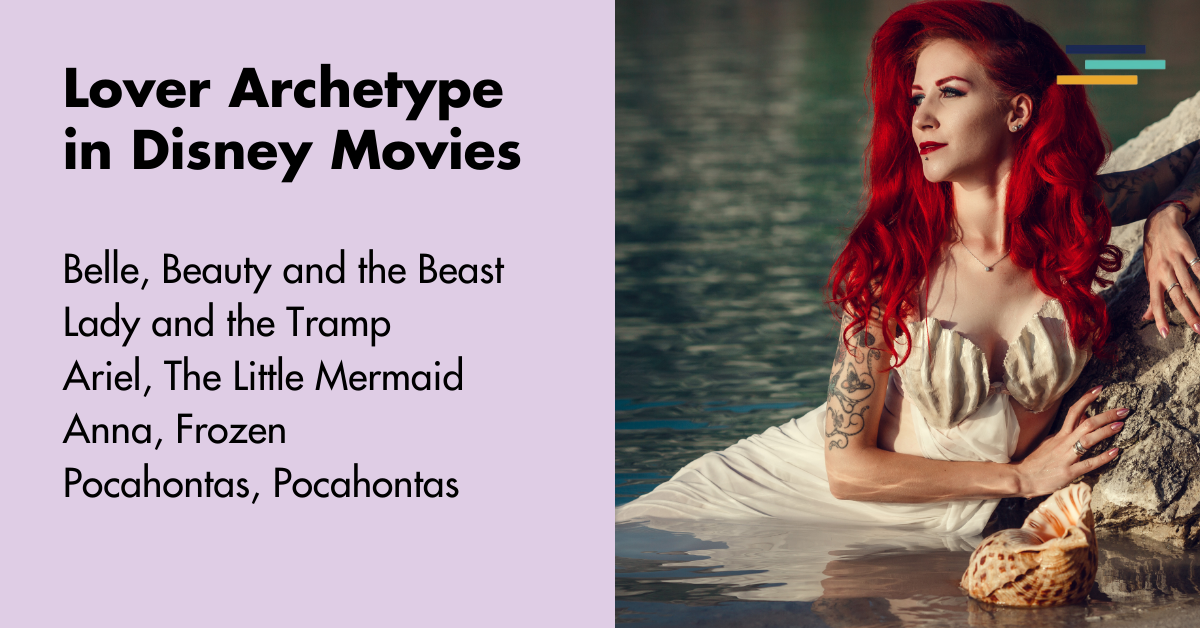
It has been said that a weak plot can be held up by strong characters, but the strongest of plots cannot survive with weak characters. Writing characters that resonate with readers is key to making your story compelling. Character archetypes are recognizable because they represent universal traits and qualities.
What is an archetype? Noted psychologist Carl Jung said this: “An archetype is “universal, inborn models of people, behaviors, or personalities” that play a role in influencing human behavior (Jung, American Psychological Association, APA Dictionary of Psychology).”
In other words, an archetype is like a blueprint or pattern that writers use to create stories that readers easily identify with.
What Is the Lover Archetype?
The lover archetype is a character motivated by their need for human connection and often possesses a strong sense of passion, intimacy, and devotion. They value long-lasting, meaningful connections and are often driven by their feelings, yearning for experiences that bring intimacy in both the physical and emotional realms. Their pursuit of love influences their decisions and transforms their lives.
Other traits often associated with the lover archetype include a sense of wonder for the world, an appreciation for artistic and beautiful things, and an eagerness to learn. They love being in the spotlight and find it easy to make friends. They feel most alive when surrounded by those they love.
While this sounds like the makings of a perfect character, the lover archetype is not without their flaws. When scorned, the lover can become bitter and self-destructive. They risk losing their self-identity and giving in to their dark side, developing addictions to replace the thing they lost. They can become emotionally fragile and display strong emotional outbursts.
The depth of their passion can lead to jealousy and obsession, a desire that overwhelms and is harmful to their mental or physical health. Often the lover archetype sacrifices too much, and they could have a powerful fear of being alone, making them clingy or dependent. They are prone to depression, suffering, and anguish because of their drive for love and passion.
Any character who has a strong sense of passion and devotion may fit into the lover archetype, but they are not limited to romantic inclinations. Consider a character who is dedicated to their craft, such as music or sculpture or cooking or writing. Having an unrestrained love for someone or something impacts their environment and actions.

Lover Archetype Examples in Literature
Examples in literature that showcase the complexities and flaws of the lover archetype include:
- Romeo Montague, Romeo and Juliet by William Shakespeare
The iconic character of Romeo is deeply passionate and impulsive. At first sight, Romeo falls deeply in love with Juliet, a love so intense it brings out his impulsiveness and emotional fragility, ultimately leading to a tragic end. His character shows some of the negative traits the lover archetype can possess.
- Noah Calhoun and Allie Hamilton, The Notebook by Nicholas Sparks
The love story of these two characters faces challenges, beginning as a summer love halted by class differences and familial expectations. Noah’s undying passion is showcased in the daily letters he sends Allie for a year, while Allie is torn between meeting societal constraints and her heart’s desire. Ultimately, their love story survives and thrives, embodying the trials and triumphs associated with the lover archetype.
- Samwise Gamgee, Lord of the Rings by J.R.R. Tolkien
He may only be the sidekick, but Sam is a faithful companion to Frodo, cheerful and kind, devoted through the darkest of times. Even when all seems lost, Sam’s strength is the key to seeing Frodo through to a happy ending. Sam’s love for Frodo drives him to go to great lengths to protect him. His loyalty, compassion, and the strong bonds he forms typify the lover archetype.
- Westley and Buttercup, The Princess Bride by William Goldman
Westley’s love for the beautiful Buttercup drives him to endure great hardships, all to prove his love and ensure her safety and happiness. Buttercup demonstrates her love for Westley through her willingness to wait for his return and to face dangers. Despite overwhelming obstacles, they remain devoted to each other, willing to sacrifice their happiness and even their lives for each other, demonstrating the character traits of lover archetype characters.
- Elinor Dashwood and Edward Ferrars, Sense and Sensibility by Jane Austen
Reserved, sensible Elinor falls in love with the kind-hearted and honorable Edward. Her sincerity appeals to him, and they share a passion for each other that remains unrequited due to duty and integrity until the end, when their actions are rewarded with a happily ever after. Their mutual respect, devotion, and steadfastness are excellent examples of the lover archetype.

The Lover Archetype Examples in Movies
- Rose DeWitt Bukater and Jack Dawson, Titanic
Rose is trapped in a controlling relationship dictated by her position of wealth and privilege. Jack, a poor artist with big dreams, saves Rose from a suicide attempt and teaches her about embracing all life has to offer. Despite challenges to their romance, they fight to stay together, and Jack proves his love by sacrificing his life for hers. Their relationship is an excellent example of the lover archetype, characterized by passion, devotion, and sacrifice.
- Baby and Johnny, Dirty Dancing
Social differences and family disapproval hinder the romance between Baby, the daughter of a doctor, and Johnny, a dancer who has been used by practically everyone in his life. When she stands up for him, it has repercussions for both of them and deepens the bond between them. Johnny publicly declares his admiration as they perform their iconic dance, demonstrating the transformative power of love. A classic example of the lover archetype, Baby and Johnny’s relationship showcases how love can bridge gaps and lead to personal growth.
- Rick Blaine, Casablanca
Rick, bitter and cynical after a broken romance with Ilsa, has vowed to remain detached from the political unrest around him in World War II Morocco. When Ilsa unexpectedly walks into his bar, he struggles with his lingering feelings and a growing sense of duty to help her husband, a resistance leader. Ultimately, his love for Ilsa leads him to sacrifice his chance to be with her when he gives valuable exit visas to provide escape for her and her husband. His faith in love restored, he joins the fight against the Germans. Rick’s character displays the lover archetype through the emotional depth of his love for Ilsa, and his transformation from aloof and disillusioned to a proactive, self-sacrificing hero.
- Scarlett O’Hara, Gone with the Wind
Scarlett is obsessed with her love for Ashley Wilkes, even after he marries another. Driven by her feelings, she makes decisions out of spite. She meets her match in Rhett Butler but realizes too late that her feelings for Ashley were just an infatuation, and it’s Rhett she truly loves. Her character demonstrates the negative aspects of the lover archetype, when obsession overrules sense.
- Bella Swan, the Twilight series
Bella meets the mysterious Edward, who turns out to be a vampire, and falls deeply in love with him, despite the dangers of being part of his world. They face numerous obstacles even after they marry, but Bella’s unwavering commitment to Edward helps her triumph over the supernatural world. Her devotion, sacrifice, and idealization of love serve as an excellent example of the lover archetype.
The Lover Archetype Examples in Disney Movies
Many Disney movies feature characters who seek deep emotional connections. Among those driven by love and passion include:
- Belle, Beauty and the Beast
Belle’s compassion and ability to look beyond appearances leads her to fall in love with the Beast, ultimately freeing him from the curse placed on him and his castle. Belle’s kind-hearted nature and love transform the Beast, helping him to learn to love and be loved in return. Their personal transformations and redemption are a classic example of the lover archetype.
- Lady and Tramp, Lady and the Tramp
Though his free spirit makes him seem selfish at first, Tramp soon demonstrates his loyalty and friendship, and the pampered Lady loses her heart to him as he introduces her to the world outside her upper-class home. During a crisis, both show their hearts and their loyalty when they unite to protect the baby in the household. Their relationship is marked by mutual growth and understanding, demonstrating how love can bridge different worlds and lead to personal transformation.
- Ariel, The Little Mermaid
Ariel longs for a different life, but when she falls for Prince Eric, she makes enormous sacrifices in the name of love, including giving up her voice and transforming into a human. Ariel’s love leads her on a journey of transformation. Her willingness to change for the sake of Eric’s love makes her an excellent example of the lover archetype.
- Anna, Frozen
Anna’s love and devotion are portrayed throughout the movie. After being isolated in Arendelle’s castle for most of her life, she is eager to experience the world and seeks out relationships. Anna’s love for her sister compels her to take significant risks to protect Elsa and bring her home safely. She embodies the lover archetype through her desire to create and nurture relationships, making others feel loved and secure.
- Pocahontas, Pocahontas
Pocahontas embodies the lover archetype, characterized by a deep passion for love and intimate relationships, as well as a profound connection with nature. Pocahontas’ relationship with John Smith, as well as her desire to broker peace between her tribe and the European settlers, demonstrate her love, devotion, and openness with her feelings.

What is the Lover Archetype?
They can be:
- A romantic partner
- An artist
- A caregiver
- A devoted friend
- An activist
- An addict
They often exhibit these traits:
- Passionate
- Romantic
- Compassionate
- Sensitive
- Intuitive
- Loving
- Empathetic
- Creative
- Devoted
- Obsessive
- Compulsive
- Idealistic
- Dependent
- Self-centered
- Jealous
- Insecure
- Overly emotional
Tips for Writing the Lover Archetype
Develop Deep Emotions
Show a character’s intense feelings through actions, dialogue, and thoughts. Employ vivid descriptions to convey their affection, passion, and devotion, whether it is for another person or for something else they feel strongly about, like a cause or an artistic endeavor.
Throw Conflict at Them
Test their loyalty and devotion with challenges, and then explore their challenges by displaying jealousy, possessiveness, low self-esteem, or idealism. Try to make challenges feel genuine and relatable, avoiding contrived or melodramatic situations.
Show Their Imperfections
It is important to not make the character either unrealistically perfect or irredeemable. Make them empathetic and compassionate while showing vulnerabilities and flaws to make them relatable.
Demonstrate Growth
Use the character’s experiences with love and friendship to display their growth, highlighting moments of self-discovery and maturation.
Give Them Meaningful Relationships
Allow your characters to build strong connections with others. Demonstrate both the positive and negative ways love impacts them.
Consider Different Forms of Love
Not all love has to be romantic. Explore other types of love, such as deep friendship, familial bonds, or self-love. How your character navigates their other relationships contributes to the depth of the lover archetype.
Use Fresh Language
Avoid overused phrases and metaphors. Reflect the romantic nature of your character through realistic conversation, using sincere language that resonates with readers.
Avoid Clichés
Steer clear of stereotypical behaviors and characteristics and be mindful of tropes. Show love through subtle, ordinary moments instead of over-the-top declarations.
Incorporate Romantic Gestures
Gestures don’t always have to be grand. Even small acts can be thoughtful ways to demonstrate love and reveal the deeper aspects of their character.
Draw Upon Real-life Experiences
Reflect on your personal experiences with love and friendship or from real-life stories. Tap into those memories and emotions to infuse authenticity into your writing.
Using the lover archetype to shape your character doesn’t have to be restrictive. Layer it with multiple archetypes to create rich, three-dimensional characters who exemplify life or maybe even defy it. Give them an interesting backstory and unique traits. Your creative vision can make the lover archetype feel fresh and unique.


